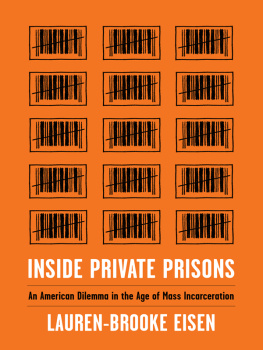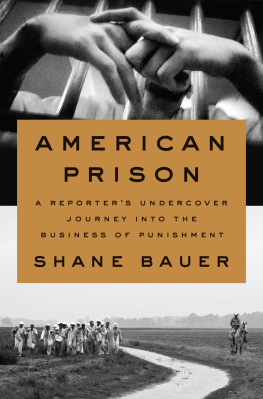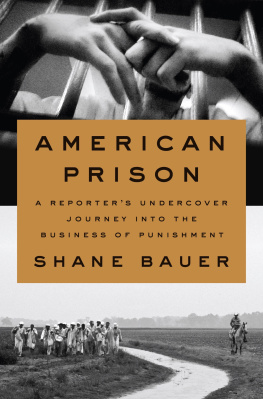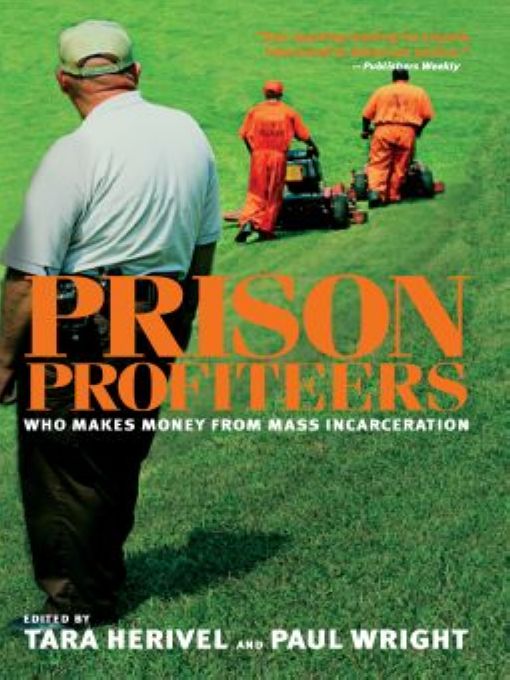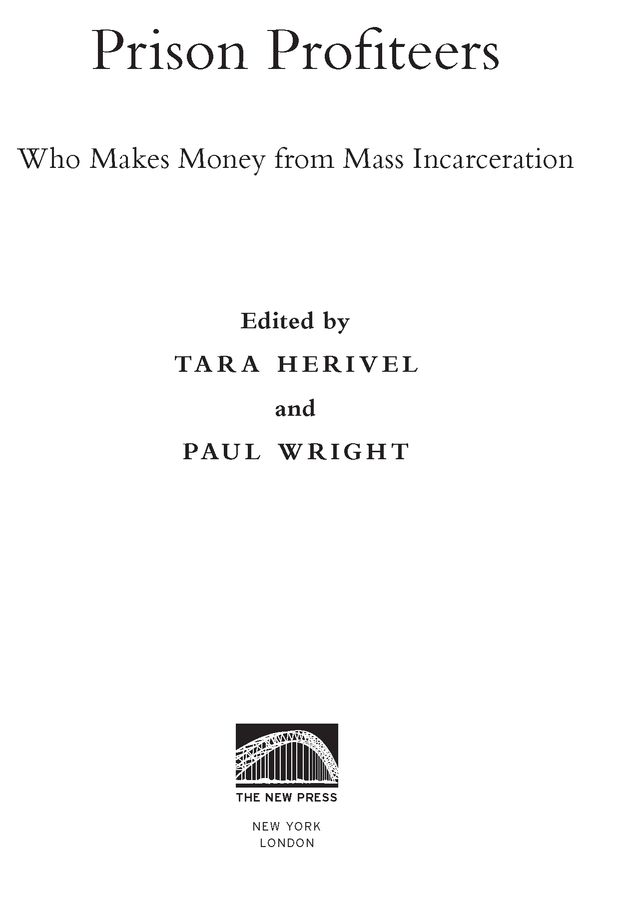Table of Contents
Introduction
Although there is an expanding body of writing and analysis regarding the harms caused by mass incarceration in America, there is little discussion about the increasing number of entities that profit from and subsequently engender the growth of prisons. Beginning with the owners of private prison companies, and extending through a whole range of esoteric industriesfrom the makers of taser stun guns, to riot security training companies, to prison health-care providers, to the politicians, lawyers, and bankers who structure deals to build new prisonsa motley group of perversely motivated interests coalesce to sustain and profit from mass imprisonment. This anthology addresses the question of who profits from the incarceration experiment, and to whose detriment.
The United States now holds the grave distinction of imprisoning the largest number of people of any country: with just 5 percent of the worlds population, it incarcerates 25 percent of the worlds prisoners. Beginning in the 1970s, America embarked upon an unparalleled experiment in industrialized mass imprisonment. At that time, U.S. prisons and jails held roughly 300,000 prisoners; by 1990, that figure grew to over 1 million. Now, around 2.3 million are imprisoned in state and federal prisons and jails, with many more in military prisons, juvenile prisons, immigration prisons, and civil commitment facilities. If adults under community supervision are included, the figure shoots upward to 7 million.
While there are many industries that make money from prisons, the private prison industry is unique in that it is the only such industry founded solely in order to profit from prisons. The private interests that attach to prisons generally take the following forms: private companies like Geo (formerly Wackenhut), and Corrections Corporation of America (CCA), which compete to purchase the contracts to staff and run private prisons for profit; corporate interests that vie to sell their wares or services to prisons; and industries eager to make use of the enormous, untapped labor pool of prisoners, for whom the usual restrictions of labor protections do not apply. More difficult to categorize is the related transference of public wealth to the prison context, such as the siphoning of public monies as politicians and bankers fund private prison ventures with state-financed bonds. This volume takes a first step into the murky, unexplored territory of the prison profiteers.
Private Prison Profiteers: Who, What, Why?
The prison profiteers are a varied and aggressive group with enormous reach. What they share is a common lack of experience in the prison arena, and an undivided focus on the bottom line: less expense, more profit.
Judy Greene, a researcher, author, and fellow at the Open Society Institute, opens the discussion with an overview of the current state of the private prison industry and its leading entities, including Geo and CCA. Greene traces the industrys growth from its nascent form in the 1970s to the thriving industry of today, highlighting the industrys iniquitous aim: to foster expansion of the prison population and keep beds filled.
Author, attorney, and this volumes co-editor, Tara Herivel, examines privatized youth facilities and evaluates the relationship between state power and private industry, as it applies to youth incarcerated in private facilities. Some of the worst examples of juvenile injustice arise in this context, including the nepotistic dealings of Louisiana politicians willing to sell off the states financial credibility and its imprisoned youths safety for sweetheart deals and state-backed bonds. In exchange for selling off the rights to its juvenile facilities to the highest bidder, Louisianas privately run juvenile facilities produced horror stories of Dickensian proportion, with a financial legacy that severely restricts that states budget to this day.
The story repeats itself around the country, with different locales and players, but the same basic scenario. Among the most disturbing questions that arise is: Why have the numbers of children in private juvenile facilities increased by 95 percent in the past decade, despite a downward turn in juvenile crime in the same time period? It appears that, where there is profit to be made, beds will be filled by an industry willing to turn a deaf ear to abuses (or even necessity) in this setting.
Journalist Silja Talvi goes undercover to provide a fly-on-the-wall perspective on the industry-insider conference held annually by the American Correctional Association (ACA), at which many of the deals that benefit private companies at the expense of prisoners and taxpayers are struck. The ACA conference draws the foremost industry players, including Geo and CCA, and serves to connect providers as diverse as Verizon, Western Union, Smith & Wesson, and Glock with those making purchasing decisions on behalf of the prison industry. Talvi also visits workshops with titles like Faith-Based Juvenile Programming and Anti-Terrorism in Correctional Facilitiesrevealing the undeniable influence of the industrys right-leaning political perspective.
Transferring Public Wealth to Prisons
Other authors track the creative transference of public monies to fund prisons and thereby enrich pro-profit prison builders in an era replete with evidence that the current rate of prison growth is financially unsustainable.
Writer and Soros fellow Kevin Pranis presents the symbiotic relationship between the promotion of private prison industries and the financial well-being of the states that fund them. In his chapter on backdoor prison financing through state bonds, Pranis shows that states are tethering themselves to privatized prison companies by providing taxpayer-funded bonds to the industry to build and maintain prisons. To ensure payment on the bonds, prison beds must be filled to capacity, creating a troubling relationship between state power, criminal justice, and private industry.
Journalist Jennifer Gonnerman investigates the phenomenon of million-dollar blocks, as illustrated by maps representing prison spending by neighborhood. The maps make clear that people in the poorest urban neighborhoods often have the highest price tags per block, with an average of $30,000 per resident per year being spent to incarcerate a large percentage of these blocks populations. With cruel irony, the prison-spending budgets for these impoverished neighborhoods are then diverted to the rural prison towns where the urban-based prisoners are housed at the expense of the poor neighborhoods from which prisoners originate.
In a similar vein, prisoner Gary Hunter and Soros fellow Peter Wagner evaluate the political and financial impact of census figures that count prisoners as residents of the communities in which they serve their time, rather than their communities of origin. Wagner and Hunter demonstrate that counting prisoners as residents of the prison towns in which they are incarcerated benefits politicians in the rural communities where prisons are sited by enlarging their districts with nonvoting members.
Proponents of rural prison-siting often make promises of improved economic health to their prospective prison town residents. But scholars Clayton Mosher, Gregory Hooks, and Peter Wood find that prison construction in rural locales actually stagnates or impedes economic health. By comparing income levels, total earnings, and employment growth between urban and rural communities with newly built prisons and those without prisons, the authors discovered that both rural and urban communities with newly built prisons grew at the slowest pace. Those who do benefit from rural prison siting are instead the political backers and bankers who funnel funds to prisons, the companies that hawk their wares to prisoncrats, and a handful of lucky locals in prison host communities who scavenge for the leftovers.






